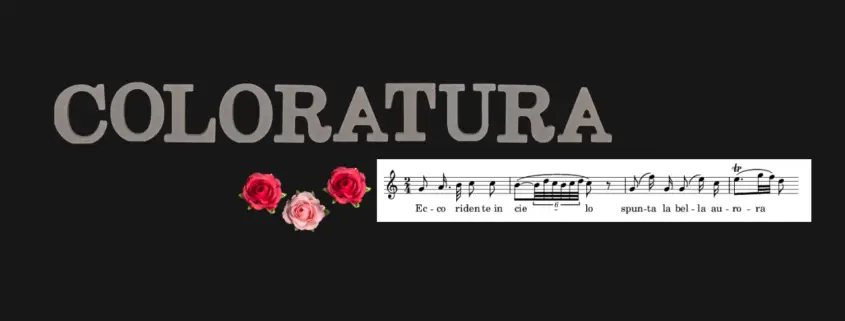What must a «coloratura soprano» be able to do?
Glossary: COLORATURA SOPRANO
This post shows the technical term COLORATURA SOPRANO explained in a few sentences with links to practical examples.
What must a coloratura soprano be able to do?

In classical music, a coloratura soprano is a soprano voice with coloratura ability, that is, a special agility, especially in the high register (Wikipedia). This includes, above all, singing chains of notes and trills and other ornaments.
The coloratura technique emerged with the appearance of CASTRATI in opera in the 17th century. Farinelli and Senesino, for example, were castrati who could master extreme difficulties and sing out long chains of notes with their vocal volume.
With Rossini, the role of the COLORATURA MEZZOSOPRANO emerged at the beginning of the 19th century, which he wrote for his lovers Marconi and Colbran (Cenerentola, Barbiere di Siviglia, Italiana in Algeri). They replaced the castrati. Donizetti and Bellini followed him on this path.
With Verdi, the soprano role became more dramatic and coloratura was used more selectively (DRAMATIC COLORATURA SOPRANO).
With Jenny Lind and Adelina Patti, the era of the LYRIC COLORATURA SOPRANO began in the course of the 19th century, and with their successors opera became an opera for “canaries”, i.e. for singers who mainly showed off their coloratura. With her legendary performances in the 1950s, Maria Callas returned Amina (Sonnambula) to its beginnings as a dramatic role and triggered a renaissance of the Belacanto works of Belini, Rossini and Donizetti, later associated with the names of Joan Sutherland, Anna Moffo or Edita Gruberova.
In addition to the lyric and dramatic coloratura soprano, there is also the SOUBRETTE role, which is a light youthful soprano, sometimes set very high, going beyond high C.
For example, a famous coloratura (mezzo) soprano of our day is Cecilia Bartoli.
[/av_timeline_item] [/av_timeline]
Rossini’s coloratura mezzo-soprano from Cenerentola:
Nacqui all affano … non più mesta: In this final piece we are met by a transformed Cenerentola. She has not only changed visually, but also blossoms musically. Rossini saved the great fireworks for the finale. What Rossini presents us with in terms of ornamentation, chains of notes and leaps in this aria is breathtaking. This piece is one of the most demanding that has been written for coloratura sopranos.
Verdi’s dramatic coloratura soprano from Il Trovatore:
Di tale amor: Leonora expresses her joy with trills and a great final expansion into high C. This virtuosic piece is very challenging for the singer and must be sung with perfect legato in order to maintain elegance without the coloratura losing luster.
Bellinis coloratura soprano from la Sonnambula:
Ah ! Non giunge: At the end of the opera Bellini composed a bravura aria for Amina with great leaps in tone, trills and top notes.
Donizetti’s lyric coloratura soprano from Lucia di Lammermoor:
Il dolce suono…Sorge il tremendo fantasma: This famous aria is a highly virtuosic piece. The so-called mad scene does not consist of an aria, but is a labyrinth of pieces that begins with an andante, then leads into a manic allegro vivace, is followed by a recitativo accompagnato, moves to a larghetto aria (with chorus) and an allegro trio with Enrico, Raimondo and full chorus, and ends in another aria plus coda. No wonder this scene is considered one of the most difficult in operatic literature. Moreover, rapid leaps in tone between high and low vocal registers and difficult ornamentation demand virtuoso coloratura technique. Donizetti originally wrote the accompaniment for a glass harmonica and added a version for flute. Nowadays, the famous passage is usually sung with the flute accompaniment.
Mozart’s soubrette soprano from the Entführung aus dem Serail:
Durch Zärtlichkeiten und Schmeicheln: Blonde’s aria is written in singspiel manner, but do not be deceived, Mozart demands great singing art from the singer, a classical soubrette role, which must be performed with elegance. Mozart also leads the voice up to the high E (in the following musical example at 3:45). The orchestra is very transparent in this number with strings only, with the effect that the voice is “in the showcase”.
Peter Lutz, opera-inside, the online opera guide



Leave a Reply
Want to join the discussion?Feel free to contribute!